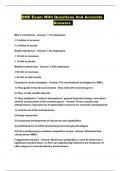Summary
Summary Unit 1 Introduction to Business - IB Business Management
- Course
- Institution
- Book
According to the new Business Management textbook (Paul Hoang's IB Business Management 5th Edition), from the cohort M2024 onwards. These summary notes cover: - Topic 1.1: What is a Business? - Topic 1.2: Types of Business Entities - Topic 1.3: Organisational Objectives - Topic 1.4: Stakeho...
[Show more]





